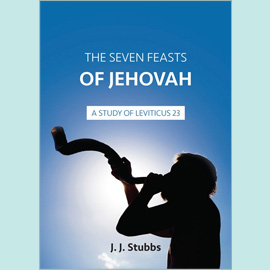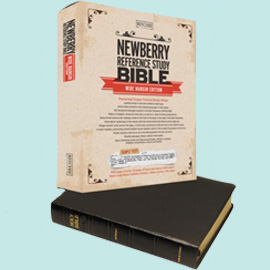
The Construction of the Table
This is the first mention in Scripture of a "table". The Table of Shewbread was made of the same materials as the Ark - shittim wood overlaid with pure gold. It measured 2 cubits (91.44 cm) long by 1 cubit (45.72 cm) broad and 1 cubits (68.58 cm) high. It was the same height as the Ark in the Holiest of All, but shorter in length and breadth. Round the top there was a crown of gold. On the outside of this crown was a border that measured a handbreadth. On the outer edge of this border there was another crown of gold. The Table had four legs. Four rings of gold were fastened to these legs at the top, close to the border. Staves were made, also of shittim wood overlaid with gold, for carrying the Table. Dishes and utensils for use with the Table were made of pure gold. Dishes on which was placed Shewbread; spoons (cups, JND) for the sweet spice incense; covers (goblets, JND) for pouring out the drink offering libations; bowls for offering the drink offerings, for they were "to cover withal" or "with which to pour out" (JND), or it may be that they were to receive the drink offerings poured out from the goblets. The border, measuring one handbreadth, was for placing securely the goblets, spoons, and bowls. The Table was placed in the Holy Place on the north side (Ex 40.22).
The Shewbread
How the bread was prepared and presented
In Leviticus 24.5-9 instructions are given in respect of the Shewbread, but a study of the Table without mention of the Shewbread would be less than complete. Weekly, twelve loaves were baked and on the Sabbath set in two rows of six upon the Table. Each loaf consisted of 2 tenth deals of fine flour, in excess of 6lbs (2.7 kilos) in weight. Frankincense was placed on each row, and after the new bread had been placed on the Table the bread that had been there for the previous seven days was to be eaten by the priests (Lev 24.9).
The names given to the bread
Cakes. The name "cakes" (2471), used of the Shewbread, is also used of the meal offering (Lev 2.4); at the consecration of the priests (Ex 29.2; Lev 8.26); in the offerings of the Nazarite (Num 6.15); and in the offering of the firstfruits in the land (Num 15.20). The word means "pierced cakes", the piercing being carried out probably to ensure that the cakes were baked in a shorter time. The spiritual significance, however, cannot be overlooked. The Lord Jesus was pierced, suffering for others even although there was in Him a beauty and fragrance which the world had never before seen or experienced. This beauty, however, could only be enjoyed by those who entered the Sanctuary.
Bread of the Presence (Ex 25.30, NKJV). This has also been translated "Bread of the Face", the point being that this bread was set before the face of God. It was there for His enjoyment and pleasure, and also that He might look on that which fed His people, sustaining their priestly exercise.
Continual bread (Num 4.7). These twelve loaves were never hidden from God, as the Lord Jesus is always before His face. Neither was this bread ever absent from the Table. As they journeyed "the continual bread shall be thereon".
Hallowed bread (1 Sam 21.4). This is how Ahimelech the priest referred to the Shewbread when David and those who were with him came to the Tabernacle at Nob, asking for five loaves of bread to feed them. This bread was hallowed, set apart for priestly use, yet Ahimelech willingly offered it to David. David was very conscious of the absence of the Ark. Without it there was no substance in what took place, nor is it recorded that there was any desire on the part of the priests or the people to have the Ark returned to the Tabernacle. Perhaps the presence of the Lord in the midst of His people was too demanding for them. What a warning! Is the presence of the Lord too demanding for His people? Is it preferable to lower standards and live in a make-belief world of empty ritual?
Loaves to be set in rows (1 Chr 9.32, JND). The orderliness of the presentation of the bread is indicated here. Everything about the Lord Jesus is ordered in a way that is pleasing to heaven.
Exposition of the loaves (Heb 9.2, JND). This again has the thought of being set out before God and is the New Testament equivalent of "Bread of the Presence".
The Significance of the Table
The fellowship of the Table
A table is a place at which meals are taken and at times the word is used to signify a meal: "Thou preparest a table before me in the presence of mine enemies" (Ps 23.5). The purpose of God in erecting the Tabernacle was not only to provide Himself with a dwelling place, but also to provide a set table at which His guests could partake and be satisfied. The table is a place of food and fellowship, for only those in harmony with each other can sit at ease at the same table. Particularly it is only those who are in fellowship with the host who can partake at his table.
The food of the Table
Of what then does the Shewbread speak? Some see it signifying the twelve tribes of Israel that are constantly before the Lord, but would that which signified His people be the food of priests? Most unlikely! Priests do not feed on the people of the Lord; they feed on the Lord Himself. The Shewbread, therefore, signified the Lord as the food of His people. The manna speaks of the Lord Jesus Christ as the food of Israel in the wilderness. The Shewbread speaks of Him as the food of His people, enjoyed in the Sanctuary.
The loaves were made of fine flour indicating the spotless perfection of Jesus, the Son of God; there was no unclean or impure grain; no husk had been ground into the flour; no chaff of any kind had left traces in the ingredients for these loaves. Here is manhood absolutely free from all traces of sin, as holy as is God. The flour could be run through the fingers and all was felt to be fine, pure, and perfect, with a smoothness leaving a sense of satisfaction that no roughening grain was there; manhood with no roughness but in every way fine and even. None of the coarseness that was seen in others, even in the most faithful of God’s servants, was to be found in Him. There was no leaven present, for sin was absent from Him and it was impossible for the Son of God to commit sin of any kind.
Yet this fine flour had to be pierced and then subject to the heat of the furnace. He had to endure temptations at the hand of Satan, sorrow at sin and its consequences, rejection by sinners and derision heaped upon Him by evil tongues, and ultimately the buffets and blows of course uncouth men as they vilified Him. Through all this He remained pure, the fine flour as fine at the end as it had been at the beginning. He delighted to do God’s will and His ear was open to His God morning by morning (Is 50.4-5).
In the Sanctuary the priests were able to partake of the loaves, and figuratively feast on Christ. The manna gave energy for the wilderness; the Shewbread gave energy for the Sanctuary. But it is vital to understand that God had enjoyed for seven days the bread on which the priests fed. For as long as He took to create a universe, He gazed on that which spoke of Christ as the food of His people. Priestly appetites were satisfied with that which satisfied heaven. Never will there be anything stale about the Lord Jesus Christ. What He is and what He endured are clothed in an eternal freshness. Frankincense was placed upon each row "for a memorial, even an offering made by fire". The procedure carried out by the priests appears to be that after the frankincense was placed on the bread, the remainder of it was burned on the Golden Altar, the sweet fragrance which arose being that of the same frankincense which was upon the bread. Thus the loaves are brought before Jehovah for His pleasure and enjoyment.
Today, Christian priests partake of this holy spiritual food. It accompanies them on the pilgrim journey, sustaining them as they travel and strengthening their worship. It is a feast that cannot fail to satisfy and that never grows stale. To feast on Christ Jesus, the true Bread of the Presence, is to enjoy provision that will give all the variety of diet required; a banquet that meets the need of every part, and never fails to amaze in its diversity.









